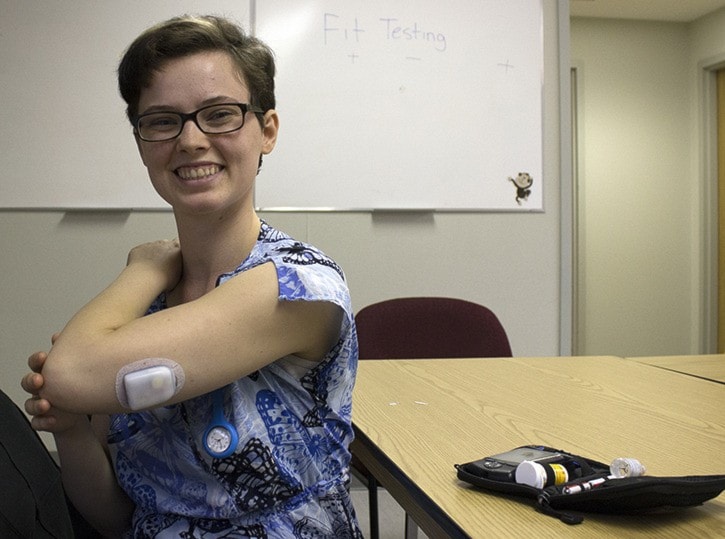Kaitlin Volk was only 13 years old when she was diagnosed with Type 1 diabetes, the latest member of a family where the disease has spanned generations.
On Friday, Oct. 14, Volk held the first Diabetes Support Group meeting at the Stettler Hospital and Care Centre. The 23-year-old said she hopes to not only help people with the disease learn to manage it, but also teach the families and friends of people with the disease how to spot danger signals.
She has good cause for her concern, as shortly after her own diagnosis, her mother, who also has Type 1, almost died. She shared the story with Gordon Smith, who had come to the inaugural meeting of the group.
"She had had diabetes for about 20 years at this point," Volk recalled. "I was down in the basement, I was 14."
Her stepfather called Volk upstairs, in a panic, because something was wrong with her mother.
"I sprinted upstairs," Volk remembered. Her mother was lying in bed, pale and lethargic and making no sense.
"She was so low her blood sugar didn't read off the meter," Volk said. "She's basically in a coma."
One of the signs of low blood sugar is a consuming hunger, but when blood sugar levels drop dangerously low, people often do not want to eat – much like how people in severe stages of hypothermia feel like they are burning up, explained Volk.
Volk's mother was in that stage, and refused the sugary drinks offered by her daughter to help rectify her condition.
In a panic, Volk mixed up the sugar and water into her glucagon, an emergency injection designed to help diabetics in a low sugar coma, or with dangerously low blood sugar. Volk compared it to the emergency epinephrine allergy device EpiPen.
"Fortunately it was super easy to use and I stabbed it into her arm," Volk said. "And sure enough, a few minutes later, she started to perk up. But the only reason I knew what to do was because I had just been diagnosed. As (diabetics), we need to teach our families what to do. If I went low, people aren't going to know what to do. They'll probably just jack me full of insulin and put me in a coma."
Every person's body reacts to the disease in their own unique ways, meaning it can be difficult for a third party to help.
"It's different for everyone," Volk said. "Somebody's highs can be another person's low symptoms. Make sure you know the person."
Misconceptions about diabetes is another problem the support group is hoping to tackle. Some is confusion about the types – 1 and 2 – and some is about how the disease affects people, according to Volk.
People with Type 1 diabetes cannot process sugar in the body properly because the organ that performs that function, the pancreas, is attacked by the immune system and dies. Adult onset diabetes, or Type 2, is caused when the body becomes resistant to insulin, making it difficult to metabolize sugar, explained Volk.
There is a stigma with Type 2 diabetes, that it is an obese person's disease, even though it can affect people with healthy weight. Type 1 diabetes is often mistaken for Type 2, passing that stigma on to sufferers of the condition.
"People don't understand (how diabetes affects you)," Smith said. "It throws wrenches around. And so many people need education."
Volk said being diagnosed with Type 1 diabetes is like having an amputation.
"You lose your pancreas," she said. "It's like having an arm cut off. Of course you go through the stages of grief."
The disease comes with some terrible side-effects, so an early diagnosis, as well as coming to term with the diagnosis quickly, is vital. People with diabetes can lose their sight, have higher chances of developing hypertension, kidney failure and infection, are slow to heal from wounds and can suffer nerve damage in their extremities. This can often result in amputations of the toes and feet.
"With diabetes, once they start cutting, it's just the beginning," Smith said.
Every person with diabetes handles the disease differently. Some people do daily injections, while others, like Volk, rely on an insulin pump.
"It's amazing," she said. "It's now one needle poke instead of 15 in three days."
The pump consists of two parts: a removable, adhesive unit which is manually filled and attached every three days, anywhere on Volk's body, and the pump's control unit. The unit communicates wirelessly to the disposable unit on Volk.
The insulin pump is just one of the newest technologies helping diabetics survive. It was only a century ago that there was no hope for people who were diabetic — such as Volk's great-aunt — as insulin had not been invented yet.
"She was my grandmother's favourite person," Volk recalled. "And she just wasted away. She was 32."
The group is new and a November date hasn't yet been set, but Volk said she intends to move it into the evening so people who are working or attend school during the day can come.
People who have questions about the group or are interested in attending can email Volk at kaitlincvolk@hotmail.com.
